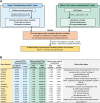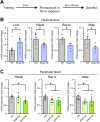Fear memory regulation by the cAMP signaling pathway as an index of reexperiencing symptoms in posttraumatic stress disorder
- PMID: 38409596
- PMCID: PMC11408251
- DOI: 10.1038/s41380-024-02453-4
Fear memory regulation by the cAMP signaling pathway as an index of reexperiencing symptoms in posttraumatic stress disorder
Abstract
Posttraumatic stress disorder (PTSD) is a psychiatric disorder associated with traumatic memory, yet its etiology remains unclear. Reexperiencing symptoms are specific to PTSD compared to other anxiety-related disorders. Importantly, reexperiencing can be mimicked by retrieval-related events of fear memory in animal models of traumatic memory. Recent studies revealed candidate PTSD-associated genes that were related to the cyclic adenosine monophosphate (cAMP) signaling pathway. Here, we demonstrate the tight linkage between facilitated cAMP signaling and PTSD by analyzing loss- and gain-of-cAMP signaling effects on fear memory in mice and the transcriptomes of fear memory-activated mice and female PTSD patients with reexperiencing symptoms. Pharmacological and optogenetic upregulation or downregulation of cAMP signaling transduction enhanced or impaired, respectively, the retrieval and subsequent maintenance of fear memory in mice. In line with these observations, integrative mouse and human transcriptome analysis revealed the reduced mRNA expression of phosphodiesterase 4B (PDE4B), an enzyme that degrades cAMP, in the peripheral blood of PTSD patients showing more severe reexperiencing symptoms and the mouse hippocampus after fear memory retrieval. Importantly, more severe reexperiencing symptoms and lower PDE4B mRNA levels were correlated with decreased DNA methylation of a locus within PDE4B, suggesting the involvement of methylation in the mechanism of PTSD. These findings raise the possibility that the facilitation of cAMP signaling mediating the downregulation of PDE4B expression enhances traumatic memory, thereby playing a key role in the reexperiencing symptoms of PTSD patients as a functional index of these symptoms.
© 2024. The Author(s).
Conflict of interest statement
The authors declare no competing interests.
Figures






Similar articles
-
PDE4B Missense Variant Increases Susceptibility to Post-traumatic Stress Disorder-Relevant Phenotypes in Mice.J Neurosci. 2024 Oct 23;44(43):e0137242024. doi: 10.1523/JNEUROSCI.0137-24.2024. J Neurosci. 2024. PMID: 39256048 Free PMC article.
-
Specific Inhibition of Phosphodiesterase-4B Results in Anxiolysis and Facilitates Memory Acquisition.Neuropsychopharmacology. 2016 Mar;41(4):1080-92. doi: 10.1038/npp.2015.240. Epub 2015 Aug 14. Neuropsychopharmacology. 2016. PMID: 26272049 Free PMC article.
-
Phosphodiesterase-2 inhibitor reverses post-traumatic stress induced fear memory deficits and behavioral changes via cAMP/cGMP pathway.Eur J Pharmacol. 2021 Jan 15;891:173768. doi: 10.1016/j.ejphar.2020.173768. Epub 2020 Dec 1. Eur J Pharmacol. 2021. PMID: 33271150
-
The downside of strong emotional memories: how human memory-related genes influence the risk for posttraumatic stress disorder--a selective review.Neurobiol Learn Mem. 2014 Jul;112:75-86. doi: 10.1016/j.nlm.2013.08.015. Epub 2013 Sep 4. Neurobiol Learn Mem. 2014. PMID: 24012801 Review.
-
Human brain evolution and the "Neuroevolutionary Time-depth Principle:" Implications for the Reclassification of fear-circuitry-related traits in DSM-V and for studying resilience to warzone-related posttraumatic stress disorder.Prog Neuropsychopharmacol Biol Psychiatry. 2006 Jul;30(5):827-53. doi: 10.1016/j.pnpbp.2006.01.008. Epub 2006 Mar 23. Prog Neuropsychopharmacol Biol Psychiatry. 2006. PMID: 16563589 Free PMC article. Review.
Cited by
-
A new psychotherapy that may treat PTSD in one session.Front Psychiatry. 2024 Nov 4;15:1440113. doi: 10.3389/fpsyt.2024.1440113. eCollection 2024. Front Psychiatry. 2024. PMID: 39564460 Free PMC article. No abstract available.
-
Candidate Anxiety-Related Genes in the Hippocampus of Hatano Male Rats: Anxiolytic Action of Neuromedin U in the Hippocampus.Neuropsychopharmacol Rep. 2025 Jun;45(2):e70018. doi: 10.1002/npr2.70018. Neuropsychopharmacol Rep. 2025. PMID: 40275722 Free PMC article.
-
PDE4B Missense Variant Increases Susceptibility to Post-traumatic Stress Disorder-Relevant Phenotypes in Mice.J Neurosci. 2024 Oct 23;44(43):e0137242024. doi: 10.1523/JNEUROSCI.0137-24.2024. J Neurosci. 2024. PMID: 39256048 Free PMC article.
-
Hyperarousal, Dissociation, Emotion Dysregulation and Re-Experiencing-Towards Understanding Molecular Aspects of PTSD Symptoms.Int J Mol Sci. 2025 May 29;26(11):5216. doi: 10.3390/ijms26115216. Int J Mol Sci. 2025. PMID: 40508025 Free PMC article. Review.
References
-
- Ehlers A, Clark DM. A cognitive model of posttraumatic stress disorder. Behav Res Ther. 2000;38:319–45. - PubMed
-
- Blechert J, Michael T, Vriends N, Margraf J, Wilhelm FH. Fear conditioning in posttraumatic stress disorder: evidence for delayed extinction of autonomic, experiential, and behavioural responses. Behav Res Ther. 2007;45:2019–33. - PubMed
-
- Michael T, Ehlers A, Halligan SL. Enhanced priming for trauma-related material in posttraumatic stress disorder. Emotion. 2005;5:103–12. - PubMed
-
- Rothbaum BO, Davis M. Applying learning principles to the treatment of post-trauma reactions. Ann N. Y Acad Sci. 2003;1008:112–21. - PubMed
MeSH terms
Substances
LinkOut - more resources
Full Text Sources
Medical
Molecular Biology Databases

